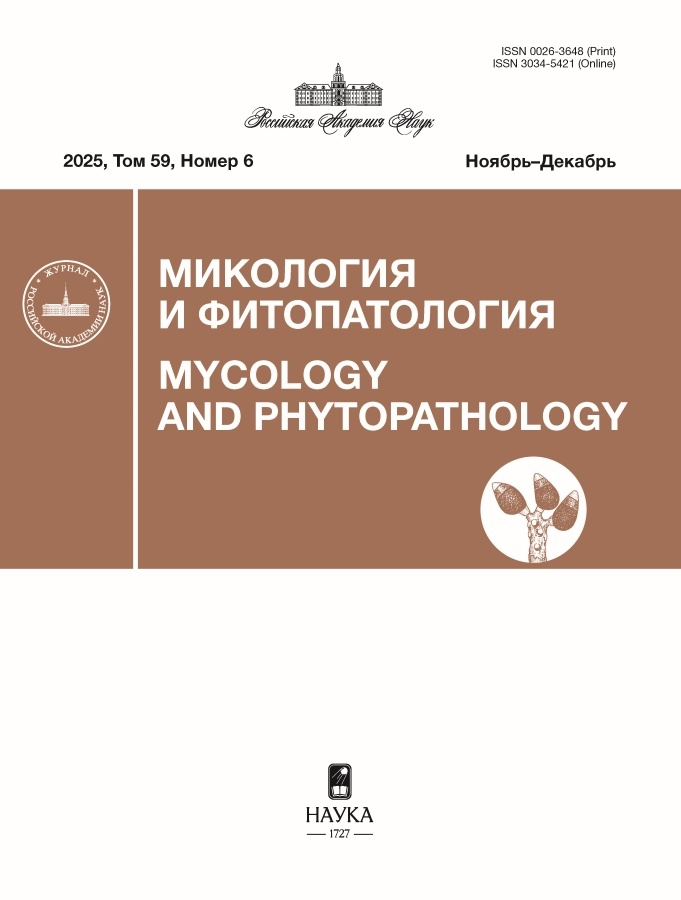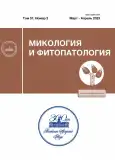Анализ структуры matA локуса половой совместимости у съедобного базидиального гриба Pleurotus ostreatus
- Авторы: Шнырева А.В.1, Шнырева А.А.1
-
Учреждения:
- Московский государственный университет им. М.В. Ломоносова
- Выпуск: Том 57, № 2 (2023)
- Страницы: 104-112
- Раздел: ФИЗИОЛОГИЯ, БИОХИМИЯ, БИОТЕХНОЛОГИЯ
- URL: https://journals.rcsi.science/0026-3648/article/view/138054
- DOI: https://doi.org/10.31857/S0026364823020101
- EDN: https://elibrary.ru/NJGWOQ
- ID: 138054
Цитировать
Полный текст
Аннотация
Съедобный гриб вешенка устричная (Pleurotus ostreatus) широко культивируется по всему миру. Морфогенез, связанный с образованием плодовых тел, находится под генетическим контролем двух несцепленных локусов половой совместимости matA и matB со множественными аллелями (тетраполярная система половой совместимости). Генетический анализ встречаемости аллелей локусов половой совместимости у 17 природных изолятов, собранных в Московской обл., показал мультиаллельность обоих локусов – 10 аллелей matА локуса и 8 аллелей matВ локуса. Анализ in silico структурной организации локуса matA у монокариотических штаммов P. ostreatus PC9 и PC15 на основе данных полногеномного секвенирования (DOE Joint Genome Institute) показал чрезвычайно дивергентную его структуру: matA локус штамма PC9 представлен одной копией гена hd1 и одной копией гена hd2, в то время как matA локус штамма PC15 имеет две копии hd1.1 и hd1.2 (класс HD1 белков) и одну копию hd2 (класс HD2 белков). Анализ аминокислотных последовательностей гомеодоменных белков HD1 и HD2 показал, что белки обладают глобулярной структурой, характеризуются ядерной локализацией и содержат вариабельный N-конец и более консервативный ДНК-связывающий домен с характерным консервативным мотивом WFXNXR в третьей ɑ-спирали. Полученные результаты позволяют утверждать, что мультиаллельность matA локуса половой совместимости достигается как за счет копийности кодирующих генов в пределах локуса, так и за счет вариабельности кодирующих генных последовательностей.
Об авторах
А. В. Шнырева
Московский государственный университет им. М.В. Ломоносова
Автор, ответственный за переписку.
Email: ashn@mail.ru
Россия, 119234, Москва
А. А. Шнырева
Московский государственный университет им. М.В. Ломоносова
Автор, ответственный за переписку.
Email: shnirevaa@mail.ru
Россия, 119234, Москва
Список литературы
- Anderson N.A., Furneir G.R., Wang A.S. et al. The number and distribution of incompatibility factors in natural populations of Pleurotus ostreatus and Pleurotus sapidus. Can. J. Bot. 1991. V. 69. P. 2187–2191.
- Arnold K., Bordoli L., Kopp J. et al. The SWISS-MODEL Workspace: A web-based environment for protein structure homology modeling. Bioinformatics. 2006. V. 22. P. 195–201. https://doi.org/10.1093/bioinformatics/bti770
- Banham A.H., Asante-Owusu R.N., Gottgens B. et al. A N-terminal dimerization domain permits homeodomain proteins to choose compatible partners and initiate sexual development in the mushroom Coprinus cinereus. Plant Cell. 1995. V. 7 (6). P. 773–783. https://doi.org/10.1105/tpc.7.6.773
- Casselton L.A., Kues U. The origin of multiple mating types in model mushrooms Coprinopsis cinerea and Schizophyllum commune. Sex in Fungi. USA: ASM, 2007. P. 142–147.
- Hartmann F.E., Duhamel M., Carpentier F. et al. Recombination suppression and evolutionary strata around mating-type loci in fungi: documenting patterns and understanding evolutionary and mechanistic causes. New Phytol. 2021. V. 229. P. 2470–2491. https://doi.org/10.1111/nph.17039
- James T.Y. Ancient yet fast: rapid evolution of mating genes and mating systems in fungi. In: Rapidly evolving genes and genetic systems. University Press, Oxford, 2012. P. 187–200.
- James T.Y., Liou S.R., Vilgalys R. The genetic structure and diversity of the A and B mating-type genes from the tropical oyster mushroom, Pleurotus djamor. Fungal Genet. Biol. 2004. V. 41. P. 813–825. https://doi.org/10.1016/j.fgb.2004.04.005
- James T.Y., Sun S., Kuo H. et al. Polyporales genomes reveal the genetic architecture underlying tetrapolar and bipolar mating systems. Mycologia. 2013. V. 105 (6). P. 1374–1390. https://doi.org/10.3852/13-162
- Kües U., James T.Y., Heitman J. Mating type in Basidiomycetes: unipolar, bipolar and tetrapolar patterns of sexuality. In: The Mycota XIV. Springer, 2011. P. 97–160.
- Kyte J., Doolittle R. A simple method for displaying the hydropathic character of a protein. J. Mol. Biol. 1982. V. 157. P. 105–132. https://doi.org/10.1016/0022-2836(82)90515-0
- Larraya L., Peñas M.M., Pérez G. et al. Identification of incompatibility alleles and characterization of molecular markers genetically linked to the A incompatibility locus in the white rot fungus Pleurotus ostreatus. Curr. Genet. 1999. V. 34. P. 486–493. https://doi.org/10.1007/s002940050424
- Larraya L.M., Pérez G., Iribarren I. et al. Relationship between monokaryotic growth rate and mating type in the edible basidiomycete Pleurotus ostreatus. Appl. Environ. Microbiol. 2001. V. 67 (8). P. 3385–3390. https://doi.org/10.1128/AEM.67.8.3385-3390.2001
- Morgenstern B. DIALIGN: multiple DNA and protein sequence alignment at BiBiServ. Nucleic Acids Res. 2004. V. 32. P. W33–W36. https://doi.org/10.1093/nar/gkh373
- Petersen T.N., Brunak S., Heijne G. et al. SignalP 4.0: discriminating signal peptides from transmembrane regions. Nature Methods. 2011. V. 8. P. 785–786. https://doi.org/10.1038/nmeth.1701
- Raudaskoski M. Mating-type genes and hyphal fusions in filamentous basidiomycetes. Fungal Biology Reviews. 2015. V. 29 (3–4). P. 179–193. https://doi.org/10.1016/j.fbr.2015.04.001
- Raudaskoski M., Kothe E. Basidiomycete mating type genes and pheromone signaling. Eukaryot. Cell. 2010. V. 9. P. 847–859. https://doi.org/10.1128/EC.00319-09
- Shnyreva A.A. Fungi of the genus Pleurotus: gene typing and analysis of the loci of mating compatibility. Diss. … Dr. Sci. Moscow, 2015 (in Russ.).
- Shnyreva A.V., Druzhinina I.S., Dyakov Yu.T. Genetic structure of the Pleurotus ostreatus sensu lato complex in Moscow Region. Rus. J. Genetics. 1998. V. 34 (12). P. 1371–1378.
- Shnyreva A.V., Shtaer O.V. Differentiation of closely related oyster fungi Pleurotus pulmonarius and P. ostreatus by mating and molecular markers. Rus. J. Genetics. 2006. V. 42 (5). P. 539–545. https://doi.org/10.1134/S1022795406050115
- Shnyreva A.A., Sivolapova A.B., Shnyreva A.V. The commercially cultivated edible oyster mushrooms Pleurotus sajor-caju and P. pulmonarius are two separate species, similar in morphology but reproductively isolated. Rus. J. Genetics. 2012. V. 48 (11). P. 1080–1088. https://doi.org/10.1134/S1022795412110105
- Sivolapova A., Shnyreva A.V., Sonnenberg A. et al. DNA marking of some quantitative trait loci in the cultivated edible mushroom Pleurotus ostreatus (Fr.) Kumm. Rus. J. Genetics. 2012. V. 48 (4). P. 383–389. https://doi.org/10.1134/S1022795412040114
- Wang G., Wang Y., Chen L. et al. Genetic structure and evolutionary diversity of mating-type (MAT) loci in Hypsizygus marmoreus. IMA Fungus. 2021. V. 12. P. 35–51. https://doi.org/10.1186/s43008-021-00086-8
- Wang W., Lian L., Xu P. et al. Advances in understanding mating type gene organization in the mushroom forming fungus Flammulina velutipes. G3-Gene. Genom. Genet. 2016. V. 6. P. 3635–3645. https://doi.org/10.1534/g3.116.034637
- Zervakis G., Balis C. A pluralistic approach in the study of Pleurotus species with emphasis on compatibility and physiology of the European morphotaxa. Mycol. Res. 1996. V. 100 (6). P. 717–731.
- Шнырева А.А. (Shnyreva) Грибы рода Pleurotus: генотипирование и анализ локусов половой совместимости. Дисс. … канд. биол. наук. М.: МГУ, 2015. 129 с.
Дополнительные файлы












